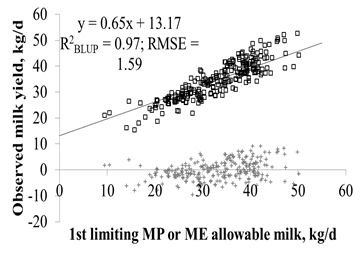
Small Ruminants, mainly sheep and goats, were the first animals to be domesticated; they are widespread throughout the world and represent a large part of the livestock body mass in the world.
Until a recent past, in the matter of Small Ruminant, the feeding rationing criteria adopted were very much connected to systems developed for Cattle, especially the NRC (USA), INRA (France) and CSIRO (Australia) systems. Small Ruminant rationings, in fact, borrowed this approach from Cattle; only different empirical adjustments were based on productive responses.
Conversely, the dynamic systems of rationing were recently introduced and are spreading in the Cattle feeding and nutrition. These systems simulate, in a mechanistic way, the effects of intake, rumen fermentations, intestinal digestion, absorption and metabolism as function of animal performances.
These dynamic systems differ from the
conventional (static) models of rationing in the nutritional values which are
intrinsic and predetermined characteristics both of the animal of the diet
eaten.
Diet characteristics are in fact the result of the weighted
average of fixed (static) nutritional parameters a priori attributed to each
ingredient included.
The most known and field used among the dynamic models is the Cornell Net Carbohydrate and Protein System (CNCPS), that reached version 6.5, utilized by the NDS Professional software platform. It is proving to be very effective in evaluations for every Cattle category diets (dairy and beef), with very high accuracy levels of prediction. It is a decision-making support tool of great interest.
CNCPS ME or MP Allowable milk

The significant developments gained in the Cattle feeding and nutrition, put into sharper focus that there were fewer diets evaluation systems for small ruminant than there were for cattle, and they were often less developed and based on simpler approaches. Considering that these systems were biologically more empirical than the cattle systems and, overall, not designed for use with dairy animals, the Cornell Modeling Group decided to work on a modification of the CNCPS for Cattle (CNCPS-C ) in order to provide a more robust sheep model (CNCPS-S), with the goal of developing a model with similar level of flexibility as does the CNCPS-C.
The Cornell Net Carbohydrate and Protein System for Sheep (CNCPS-S), subsequently evolved into the Small Ruminant Nutrition System (SRNS), is a feeding system derived from the CNCPS for Cattle. It is able to predict energy and protein requirements, feed biological values, and body weight gains and losses for all sheep and goats animal type.
Small Ruminant Net Carbohydrate and Protein System - SR-NCPS
Based on what it has been described and wanting to move forward on the development of a multi-species platform, RUM&N Sas released the SR-NCPS, acronym of Small Ruminant Net Carbohydrate and Protein System. It is a dynamic computer model based on the structure of the Cornell Net Carbohydrate and Protein System for Sheep and designed for the evaluation of diets and the performances allowed for Sheep and Goats.
The goal of the model is to predict the requirements and the utilization of protein and energy, based on different influences that could modify demands and use of feeds for productions. Metabolizable energy and protein (ME and MP) requirements vary for animal type, environment characteristics, management and feeding system.
ME and MP contributions to the diet are based on the quality and quantity of feed intake, rumen fermentation of carbohydrates and proteins degradation, microbial yield, the passage and intestinal absorption of nutrients and on the partitioning among different physiological functions. The value of the system is its ability of both identifying, with high efficiency, those factors that limit small ruminant performances and quantifying their effects in an independent way.
The SR-NCPS model simulates nutrient supply effects, rumen fermentations, intestinal digestion, absorption and metabolism on performances. Feed biological values are predicted based on carbohydrate and protein fractions and their ruminal degradation rates, forage, concentrate and liquid passage rates, microbial growth, and physically effective fiber. Particularly, the predicted supply of nutrients from each feed is driven by new solid and liquid ruminal passage rates, which are significantly different from those observed in Cattle.
The uses you can make are:
- predict the effects on productions of the diet;
- predict the effects of the modifications on a digestive and metabolic level on animal performances;
- evaluate and balance the recipe;
- satisfy the requirements and estimate productions for a large variety of environmental and management conditions;
- illustrate and predict the effects of some gastrointestinal parameters on feeds utilization;
- compare dynamic model evaluations with those made by traditional static systems.
The SR-NCPS model consists of two components:
- Sheep Module;
- Goats Module.
Sheep Module
Dynamic model for diet formulation of the following sheep animal type:
- Lactating ewes;
- Flushing ewes;
- Dry ewes;
- Ewe lambs;
- Fattening lambs;
- Rams.
Goats Module
Dynamic model for diet formulation of the following goats animal type:
- Lactating does;
- Dry does;
- Female kids;
- Male kids;
- Bucks.